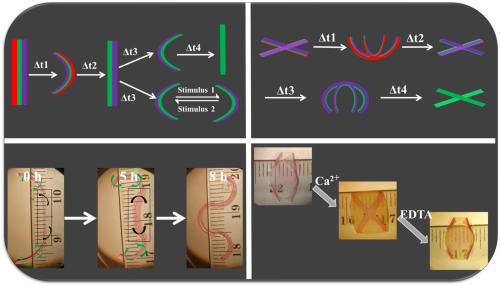Mar 2 2021
For a long time, tissue engineering has relied on geometrically static scaffolds that are seeded with cells in the laboratory to make new tissues and even organs.
 4D hydrogel-based materials can undergo multiple conformational shape changes in response to environmental cues. Image Credit: Aixiang Ding.
4D hydrogel-based materials can undergo multiple conformational shape changes in response to environmental cues. Image Credit: Aixiang Ding.
Generally, the scaffolding material is a biodegradable polymer structure that is provided with cells, and if the cells are supplied with proper nutrients, then they develop into a tissue as the basic scaffold biodegrades. However, this model disregards the exceptionally dynamic morphological processes that form the basis of the natural growth of tissues.
Currently, scientists from the University of Illinois Chicago (UIC) have designed new 4D hydrogels—3D materials with the potential to modify their shape over time in reaction to stimuli—that can morph several times in an on-demand or preprogrammed way in response to external trigger signals.
A new study published by the UIC scientists in the Advanced Science journal, and headed by Eben Alsberg, demonstrates that these new materials might help develop tissues that mimic their natural counterparts more closely, where the natural materials are subject to forces that induce movement at the time of their development.
The hydrogels can be programmed or induced to undergo multiple controllable shape changes over time. This strategy creates experimental conditions to partially mimic or stimulate the continuous different shape changes that developing or healing tissues undergo, and it may let us study morphogenesis and also help us engineer tissue architectures that more closely resemble native tissues.
Eben Alsberg, Study Corresponding Author and Richard and Loan Hill Professor of Biomedical Engineering, University of Illinois Chicago
The novel material has been developed using different hydrogels that shrink or swell at various rates and extents in response to the concentration of calcium or occurrence of water. By making intricate layering patterns, the team can direct the conglomerate material to bend in one way or another as the layers shrink and/or swell.
We can change the shape of these materials by adjusting, for example, the amount of calcium present.
Eben Alsberg, Study Corresponding Author and Richard and Loan Hill Professor of Biomedical Engineering, University of Illinois Chicago
Alsberg is also a professor of orthopedics, pharmacology and mechanical and industrial engineering at UIC.
During the experiments, the researchers could make the hydrogel form into pockets with a shape similar to that of alveoli, the small sac-like structures in the lung where gas exchange occurs.
Alsberg’s hydrogels not just change their architecture several times but also are highly cytocompatible, that is, they can have integrated cells and the cells stay alive—something that various current 4D materials are incapable of doing.
We are really looking forward to pushing the limits of what our unique hydrogel systems can do in terms of tissue engineering.
Aixiang Ding, Study Co-First Author and Postdoctoral Research Associate, University of Illinois Chicago
Oju Jeon, a research professor from UIC is also a co-first author of the study. The other co-authors of the paper are Rui Tang, Yu Bin Lee and Sang Jin Lee from UIC.
This study was financially supported by grants from the National Institutes of Health’s National Institute of Arthritis and Musculoskeletal and Skin Diseases (R01AR069564, R01AR066193), the National Institute of Biomedical Imaging and Bioengineering (R01EB023907), and the National Heart, Lung and Blood Institute (T32HL134622).
Journal Reference:
Ding, A., et al. (2021) Cell‐Laden Multiple‐Step and Reversible 4D Hydrogel Actuators to Mimic Dynamic Tissue Morphogenesis. Advanced Science. doi.org/10.1002/advs.202004616.